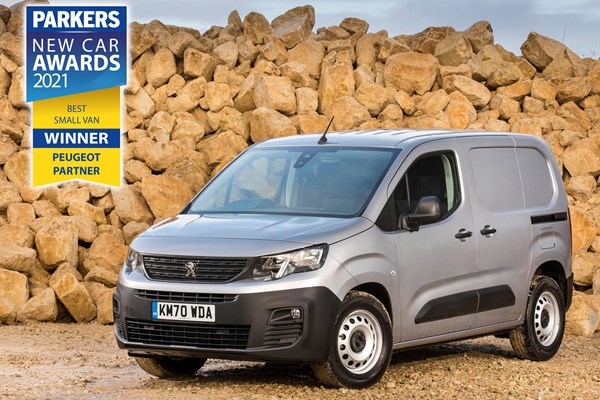Peugeot Partner van review (2023)
Award-winning small van that's versatile and good to drive
PROS
- Compact dimensions yet large inside
- Lots of cab storage space
- Efficient engines, easy to drive
- 1,000kg payload potential
- Good levels of useful technology
CONS
- Dashboard layout won’t suit all drivers
- Some hard surfaces in the cab
- Fiddly air-con controls
- Laggy touchscreen
- Best tech limited to top spec models
Summary
The Peugeot Partner is joint winner of the Parkers Small Van of the Year Award in 2021 and 2020. Read our 2023 Peugeot Partner review to find out why it impressed us so much, and we'll take you through all the pros and cons of this clever little van.
The latest Peugeot Partner is one of the newest small vans on the market, having launched into the UK in 2019. It tempts buyers with keen value, a great driving experience, impressive amounts of technology and high payload ratings.
There is also a 100% electric version, which is covered in our separate Peugeot e-Partner electric van review.
Family and other rivals
As ever, the Partner and the Citroen Berlingo are the same van underneath the branding, though the differences in the cabin are more obvious this time round, with the Partner adopting Peugeot's novel i-Cockpit dashboard layout and tiny steering wheel.
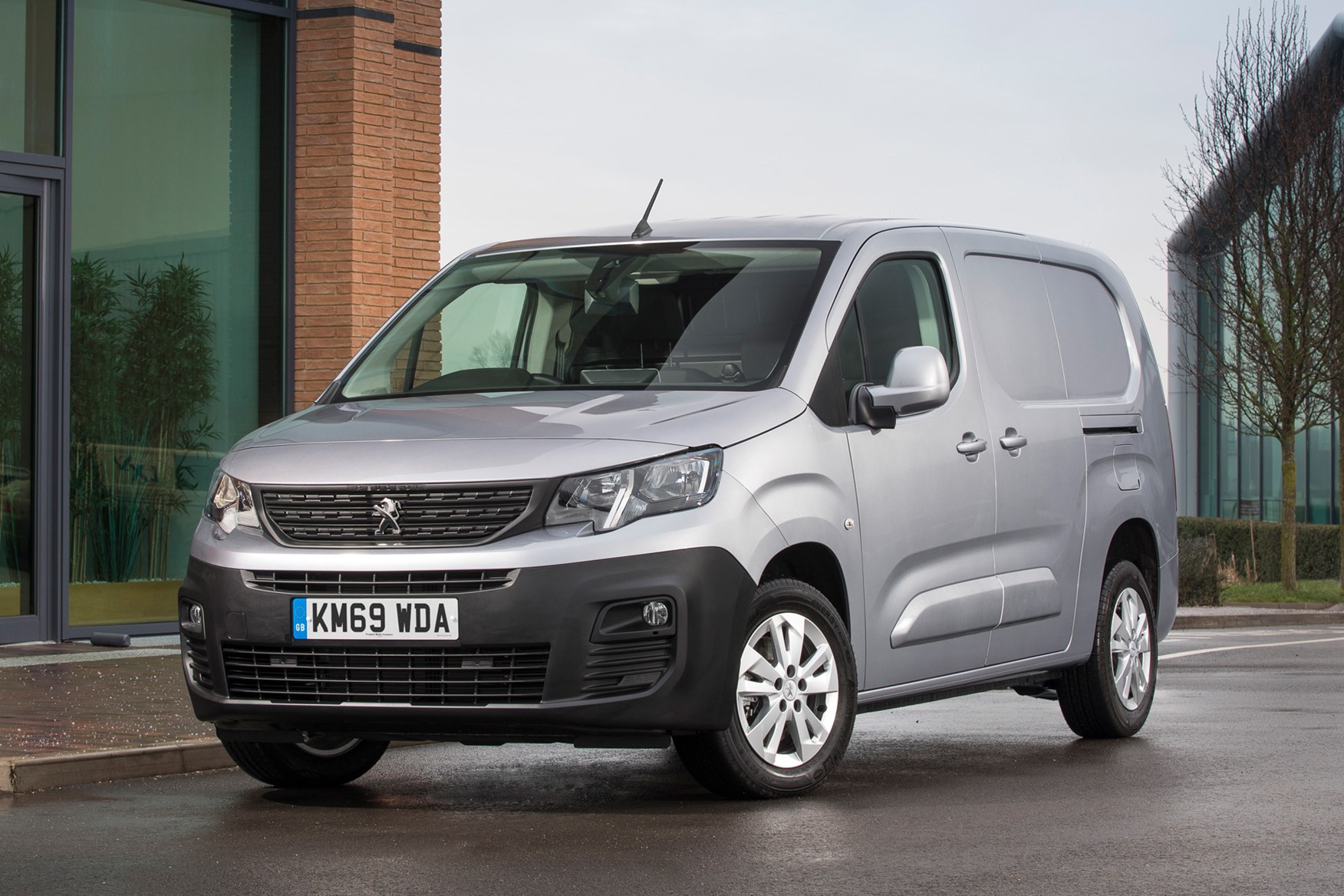
This Partner also shares its platform with the Vauxhall Combo Cargo (the British brand is part of the same Stellantis family of companies), and there's a Toyota version badged Proace City as well.
In addition to this in-house competition, the Partner also faces stiff challenges from the Volkswagen Caddy and Ford Transit Connect. Other rivals include the Renault Kangoo and Fiat Doblo Cargo..
>> Find out more about the best small vans in the UK
Body lengths and variants
The Partner is available in two body lengths: Standard L1 and Long L2 (a bit simpler to understand than the Berlingo's M and XL), with extra length gained from a stretched wheelbase and extended rear overhang for the longer version.
The Partner in Standard length will carry over 1,000kg in the back (depending on the model), with the Long model’s limit 50kg less. Both will swallow a pair of Euro pallets - for more info see our Peugeot Partner Dimensions page.
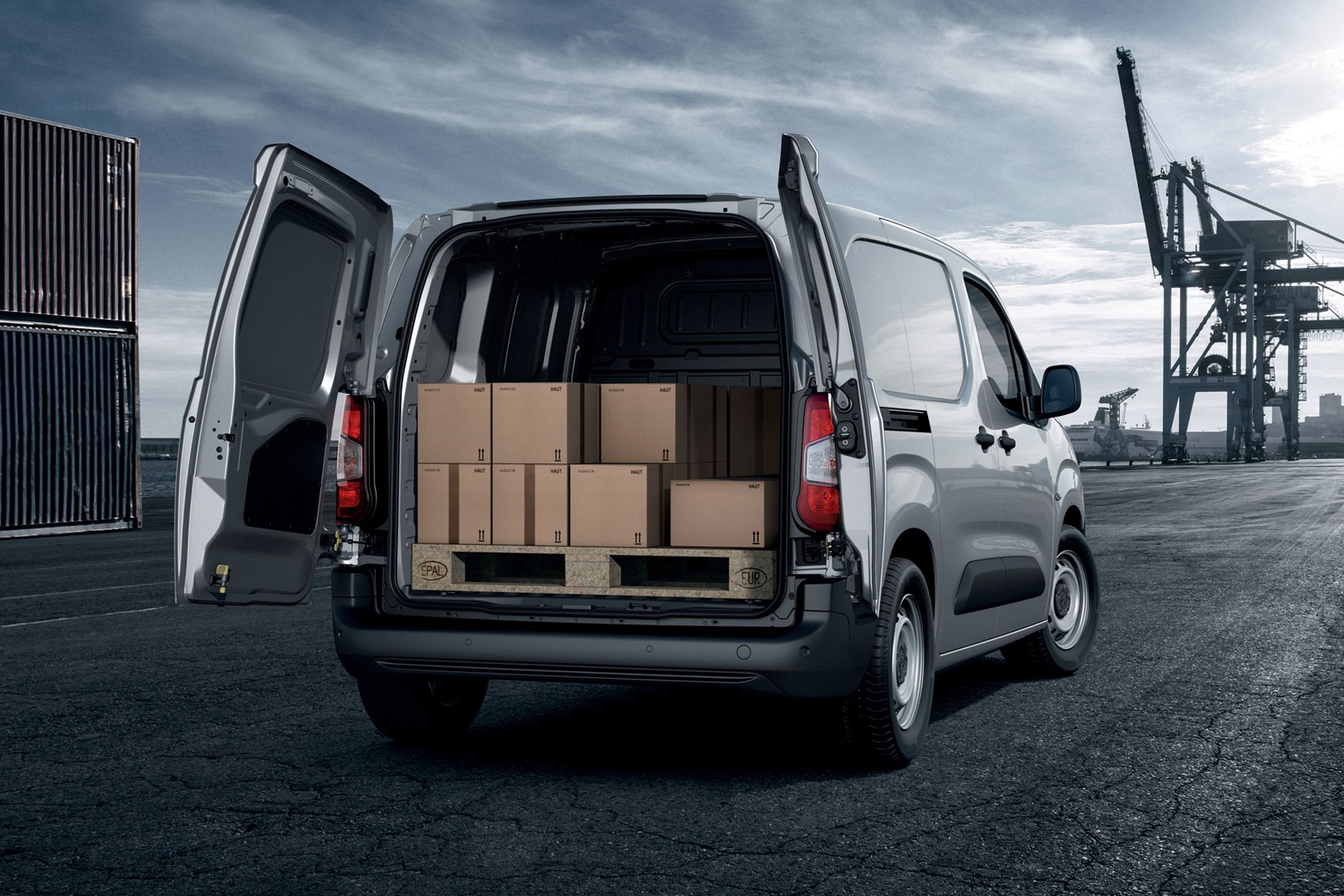
Up front, Standard models can come with either two or three front seats, while as of October 2019 the Long model is available as a Crew Cab with a second row of seats, meaning you can have up to five seats in total.
The Crew Cab also includes a moveable bulkhead/grille partition, which means that it can be almost as practical as the regular van, thanks to second-row seats that can fold down when not required.
The Partner has been sold with a choice of diesel and petrol engines, plus as the electric version we mentioned earlier. However, at present only diesel and electric models are available to buy new.
Verdict - is the Peugeot Partner any good?
The Peugeot Partner has a load bay large enough for two Euro pallets, high payload ratings, a wide range of efficient engines, and a safe, secure drive. This is a substantial enough set of accolades to see the Partner join its family members as Parkers Small Van of the Year for two years running in the 2020 and 2021 Parkers New Car Awards.
Where the Peugeot distinguishes itself is with a unique interior design. Some may love this about it, but if you don’t like change, or simply want a van that several people will be able to get in and drive without any form of mental adjustment, you’re probably best going for the Berlingo, Combo Cargo or Proace City instead.
The Toyota was the 2022 and 2023 Small Van of the Year all on its own, thanks to 10 years years of warranty coverage at no extra charge.
That said, the Transit Connect remains well worth a look, too, and since everything else about the Partner is identical to its siblings it will always be worth seeing what kind of deal the local Peugeot dealer can do for you. Keep reading for further details about this excellent small van.
Skip to our full verdict on...
- Efficient and refined diesel engines
- Three-cylinder petrol also available
- Easy to drive, but dashboard may frustrate
Unsurprisingly, the Partner drives pretty much exactly the same as the Berlingo, Combo and Proace City, thanks to shared underpinnings and engines.
That means a range of efficient diesel engines that suit the Partner’s size well, and a composed drive with neat handling and impressive manoeuvrability thanks to the (partially) new structure underneath. The front uses parts from the firm’s latest EMP2 platform that underpins many Peugeot passenger cars, while the rear of the Partner uses the previous van platform.
Peugeot Partner engines and gearboxes
There were three diesel engines at launch in January 2019:
- BlueHDi 75: 1.6-litre, 75hp @ 3,500rpm / 230Nm @ 1,750rpm
- BlueHDi 100: 1.6-litre, 99hp @ 3,750rpm / 254Nm @ 1,750rpm
- BlueHDi 130: 1.5-litre, 131hp @ 3,750rpm / 300Nm @ 1,750rpm
This range was updated for Euro 6.2 (also known as Euro 6d-Temp) in September 2019, which saw the two 1.6-litre motors replaced by similarly powerful but newer 1.5-litre alternatives:
- BlueHDi 75: 1.5-litre, 76hp @ 3,500rpm / 230Nm @ 1,750rpm
- BlueHDi 100: 1.5-litre, 102hp @ 3,500rpm / 250Nm @ 1,750rpm
- BlueHDi 130: 1.5-litre, 131hp @ 3,750rpm / 300Nm @ 1,750rpm
More recently, however, Peugeot has dropped the BlueHDi 75, leaving buyers with a choice of only the BlueHDi 100 and the BlueHDi 130 as of January 2023.
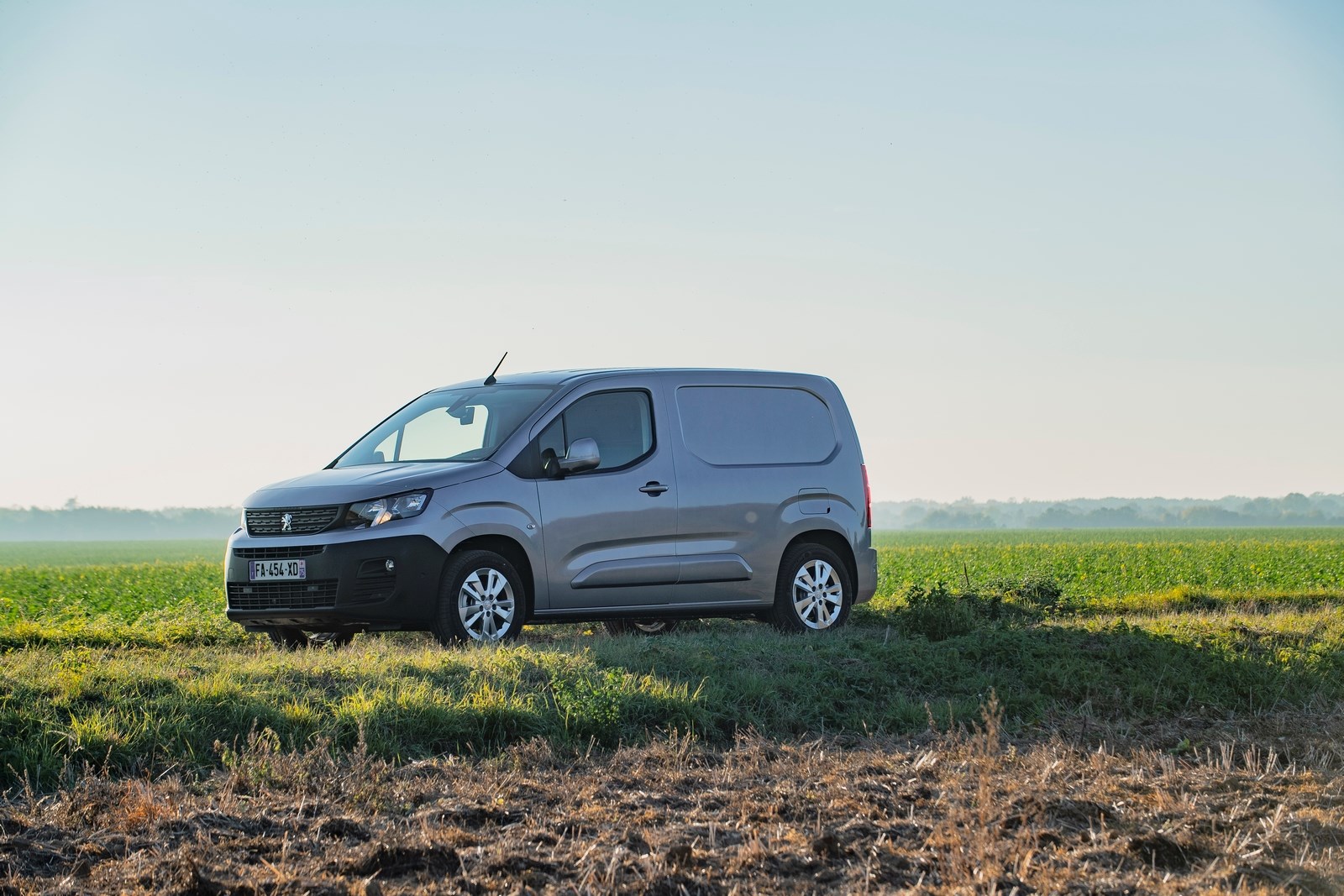
This makes sense, as the BlueHDi 100 has always been the bestseller, while the BlueHDi 130 targets customers looking for a slightly more premium driving experience, and as now available only with an eight-speed automatic transmission, badged EAT8.
Similarly, while the BlueHDi 100 was originally fitted with the same five-speed manual gearbox as the BlueHDi 75, the latest models come with a six-speed manual transmission. This makes them quieter at speed and more fuel efficient. Good news all round.
The six-speed manual gearbox feels a little slicker and more pleasant to use than the five-speeder, too. The eight-speed auto is used in a lot of Peugeot vehicles, and has consistently proved a smooth-shifting and responsive transmission. Very swish for a van.
Is the Peugeot Partner PureTech petrol any good?
While available, the PureTech 110 petrol was a 1.2-litre turbocharged engine with 110hp (5,500rpm) and 205Nm (1,750rpm). A niche choice compared with the diesels, which offer greater long-distance fuel economy and more torque, it's not a great surprise to find it's been discontinued.
However, the petrol could still make sense to those using the Partner mostly in town, as petrol is better suited to short journeys than diesel, and should be cleaner in terms of harmful particulate emissions, too.
It’s an eager engine, and though it needs to be revved, it’s surprisingly capable of dragging itself up a hill thanks to remarkably strong pulling power. That said, it does become a little gruff when driven hard, and it will require quite a bit of gearchanging to ensure swift progress at all times.
What's it like to use the small steering wheel in the Peugeot Partner?
On the road, the Partner provides good visibility and tidy handling, which helps prevent it seeming too big or cumbersome on tighter roads, whether that’s in town or on a twisty lane.
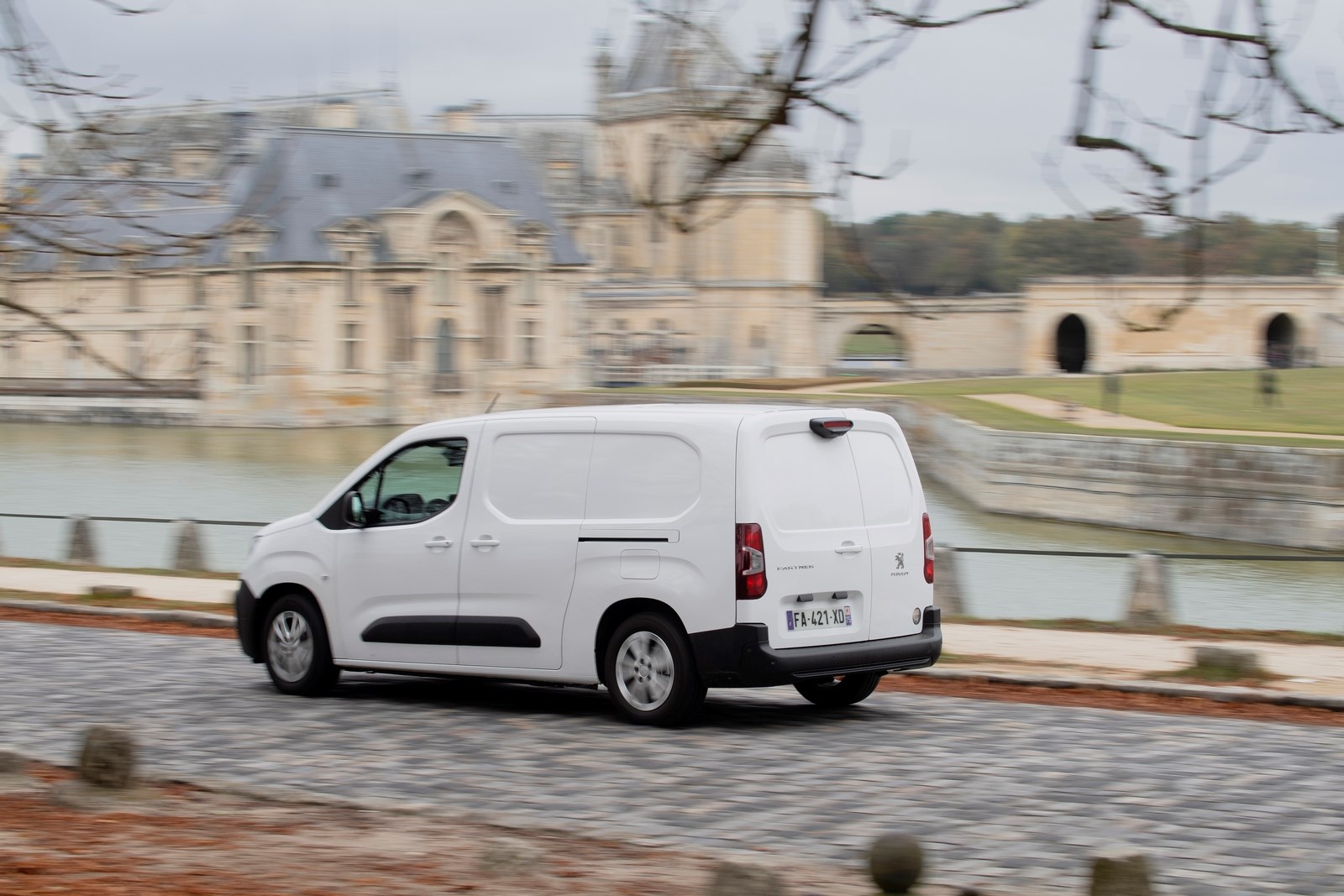
The steering is light and quick to respond to inputs, which makes manoeuvres easy. Much of this is down to the small steering wheel, which delivers quite a darty sensation when turning.
This can seem slightly odd at first, however, and you may find yourself turning too much initially. You’ll quickly get used to it in everyday driving, but there's no doubt the alternative Citroen and Vauxhall versions of this same van, which feature conventionally sized steering wheels, both feel a little more natural.
How comfortable is the Peugeot Partner?
It’s a comfortable van, with good seats and a compliant ride – but it’s worth bearing in mind that the diesels, particularly the BlueHDi 130, seemed to ride better than the petrol over imperfections in the road surface when we drove them back to back.
Higher-spec models come with greater levels of insulation around the windscreen and windows, making them delightfully quieter. But the engines aren’t especially noisy anyway, only becoming uncomfortably loud when you’re really revving them. That’s unlikely to be an issue for most, and the rest of the time it’s a refined van that does well to isolate engine sound from the cab.
Wind noise around the large door mirrors is noticeable, but at least visibility is good.
- Controversial i-Cockpit dashboard design
- Still lots of storage in the cabin
- Comfy seats and good refinement
Behind the wheel of the Peugeot Partner is where you'll notice the biggest difference between this and the Citroen, Toyota and Vauxhall equivalents.
What's i-Cockpit all about?
The Partner was the first of Peugeot’s vans to feature a version of the company’s i-Cockpit interior design. That means it has a smaller-than-average steering wheel and an instrument panel that sits higher on the dashboard than a conventional set of dials.
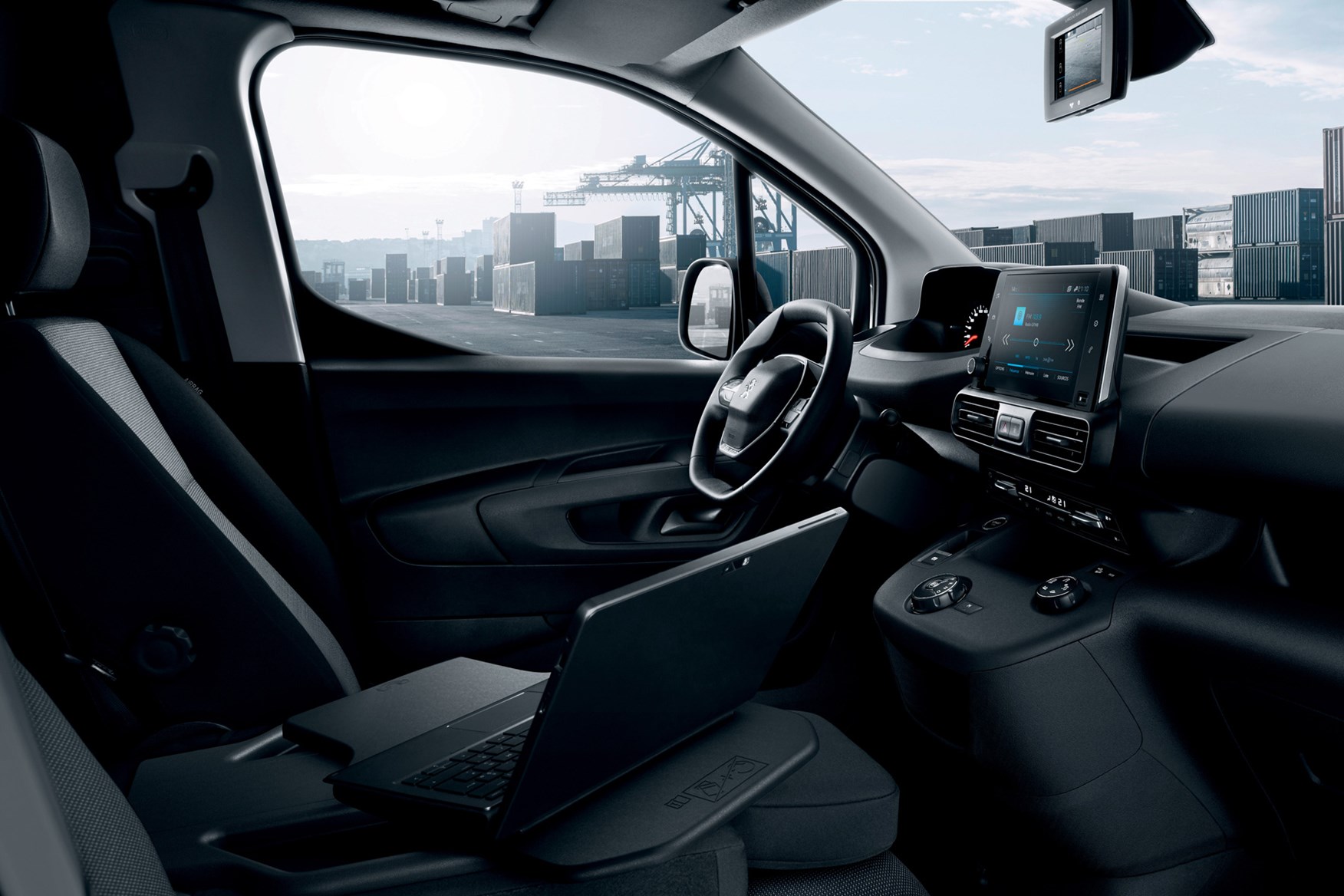
In its cars, Peugeot says this promotes a sportier feel, but we’re not sure it’s as effective on a commercial vehicle. It takes a little longer to get comfy and settled due to this set-up, and as you sit higher up in this van than you would in a car, it can feel a little unnatural. Taller drivers may also struggle with the steering wheel so close to their knees, while the top of the steering wheel can obscure the dials slightly for others.
In short, it’s not as easy to jump in and drive as the Combo or Berlingo – we found we had to stop and tweak and fiddle with the steering column to get it just right, whereas there were no such issues with the others.
Plenty of storage space inside
The above aside, the interior layout is the same as its sister vans, with a large touchscreen infotainment system sitting proud of the dashboard and angled slightly towards the driver, meaning it falls to hand easily.
The air-con controls look a little tucked away – which they are – and can be a little fiddly to operate quickly on the move as they’re also quite small and low down.
Storage is good, though, with a large shelf above the seats, a box on the dashboard where the airbag used to live (it’s now in the roof), a small area beneath the dials and a place for your phone by the gearlever. The door bins are also large, while a pair of cupholders flank the dashboard by the windows.
High-tech features - but do they work?
We've already noted the touchscreen. But though it looks nice and modern, this can be a bit fiddly to use on the move, as it's not the most responsive thing and the software isn't as intuitive as some rival systems (such as those fitted in Volkswagen vans, for example).
Among the optional upgrades is the Surround Rear Vision package (standard on top-spec Asphalt models).
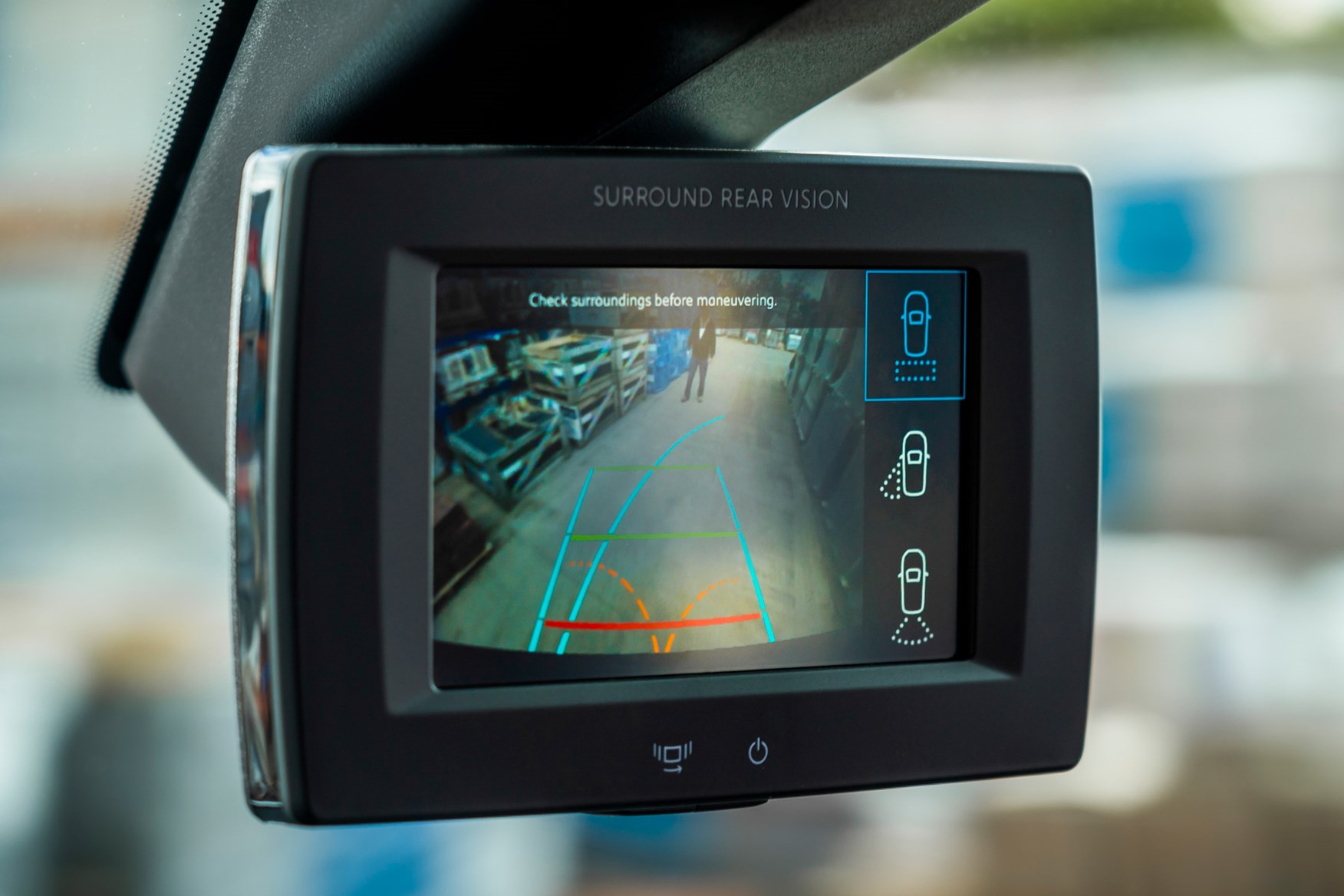
This is a camera system that offers a permanent view of the road behind via a screen where the rear-view mirror would traditionally live. You can also press a button to see a view down the passenger-side of the van, which is an effort to eliminate a blindspot.
The resolution on these cameras isn't very impressive, though, and they're not very good at dusk or in the dark (especially the side view one), so we'd probably suggest spending the money on a set of conventional blindspot monitors instead.
The Partner was also launched with much fanfare about a built-in overload sensor - called the Overload Indicator - intended to prevent drivers accidentally breaking the law by loading too much stuff inside. It was offered as an option and on higher end models but there was patchy availability for this with it not always offered and it was ultimately and finally removed as an option in July 2022.
- Diesels all claim impressive economy
- CO2 emissions pleasingly low
- Should prove cheap to run
Most small vans promise good running costs, and the Peugeot Partner is one of the most modern designs around, with strong efficiency one of its major selling points.
Peugeot Partner mpg
The latest official WLTP fuel economy claims for the Peugeot Partner van are:
- BlueHDi 100 (1.5-litre - with six-speed manual gearbox) : 47.0-55.7mpg
- BlueHDi 130 (1.5-litre - with eight-speed automatic only) : 44.7-50.7mpg
Here's a little historical data covering more of the engine choices:
- BlueHDi 75 (1.5-litre) : 45.6-51.4mpg
- BlueHDi 100 (1.5-litre - with five-speed manual gearbox) : 46.3-54.0mpg
- BlueHDi 130 (1.5-litre) : 42.8-50.8mpg
- PureTech 110 (1.2-litre petrol) : 36.7-44.1mpg
All diesel Partners have a 17-litre AdBlue tank for emission purposes, which will require topping up periodically.
Peugeot Partner service intervals
Service intervals are 15,000 miles / one year for the 1.6-litre BlueHDi 75 and 100 engines, moving to 25,000 miles and two years for the newer 1.5-litre BlueHDi engines.
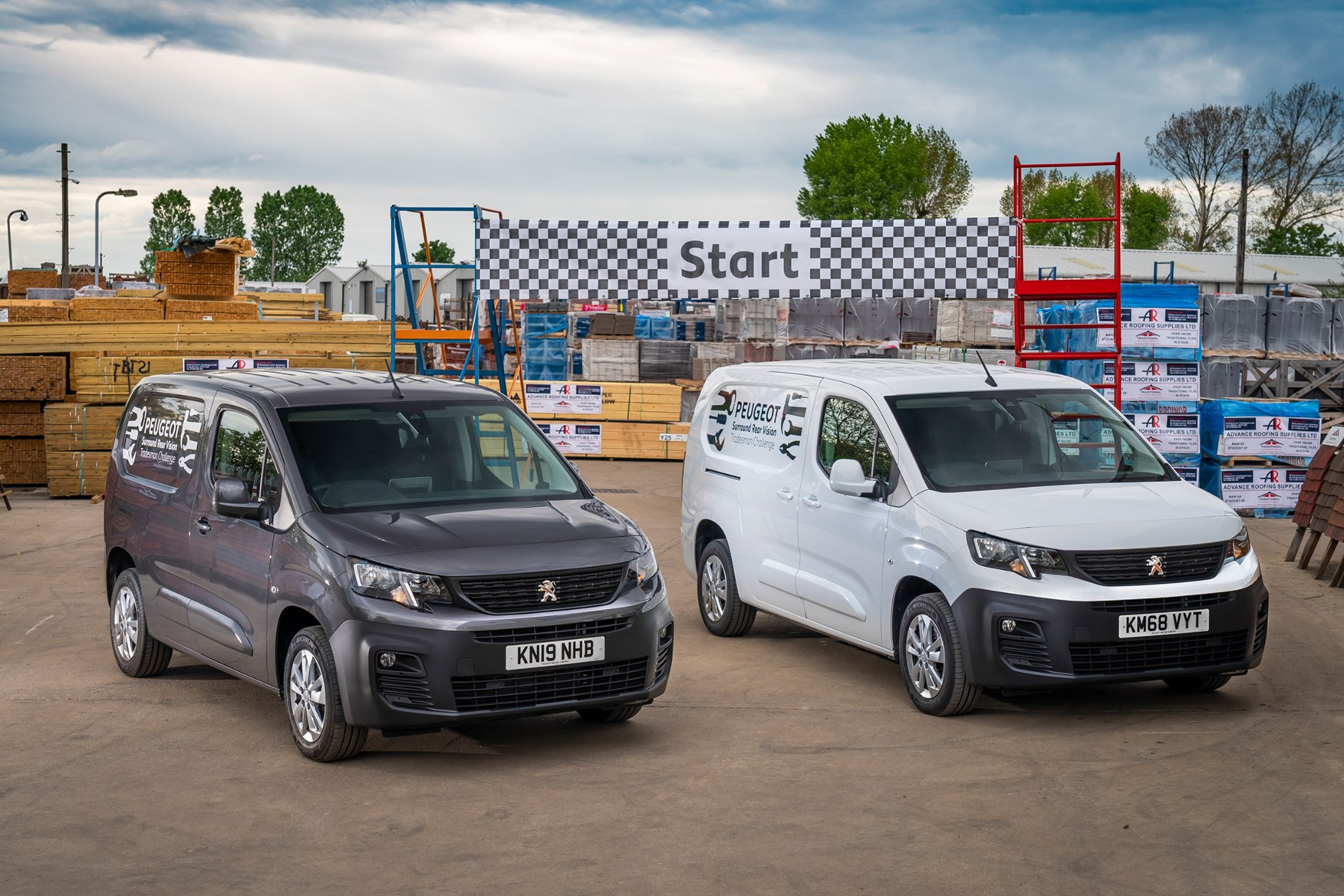
As with most modern vans, these are variable intervals, so if the vehicle detects that the oil is getting a little tired it will alert you that a service is required, even if it comes sooner than the official periods suggest it should.
Peugeot Partner warranty
The Partner is covered by a three-year / 100,000-mile warranty.
Peugeot Partner trim levels and equipment
The latest Peugeot Partner standard equipment details are as follows.
Peugeot Partner Professional Premium+ standard equipment highlights:
- Air-conditioning
- Rear parking sensors
- Cruise control with variable speed limiter
- Automatic electronic parking brake
- Full bulkhead
- Alarm
- One-touch electric windows with electric heated door mirrors
- Tyre pressure monitor
- Driver's seat with height and lumbar adjustment
- Single passenger seat
- DAB radio
- Bluetooth, USB and Aux-in
- 8.0-inch touchscreen with Apple CarPlay and Android Auto connectivity
- Front foglights
Peugeot Partner Asphalt Premium+ standard equipment highlights (in addition to Professional Premium+):
- Comfort driver’s seat
- Extra sound insulation
- Automatic wipers
- Body-coloured rear bumper, mirrors, door handles and rubbing strips
- Hard plastic floor protection
- Multi-Flex modular folding passenger bench seat with load-through bulkhead and writing table
- Peugeot Connect TomTom sat-nav system with voice recognition and multifunction steering wheel
- Surround Rear Vision package with front and rear parking sensors plus rear and side (blindspot) cameras with dedicated 5.0-inch screen
In the past, the Partner was offered with a dedicated version that was designed to spend time off road and on worksites. This was the Grip model and built on the basic S trim, which is also no longer offered. You can still get the kit that toughens up your Partner, but this is now available only in a pack. This is the Worksite Pack, and can be added to either trim for £500. This brings hill descent control, mud and snow tyres, raised ground clearance, underbody protection plate and a full size spare wheel.
The Partner uses mechanical components found in the previous-generation van, as well as newer parts found in many of the firm’s passenger cars; all are tried-and-tested and so far there are no signs of major problems.
If anything does go wrong, a comprehensive three-year warranty should keep you rolling.
Some of the company’s touchscreen systems can be a little slow to respond (as we’ve found), so make sure you’re on top of any software updates to keep this performing as quickly as possible.
>> The UK’s most reliable vans according to the FN50 reliability survey
- Up to 20 driver assistance systems…
- … but most cost extra
- Clever camera systems and secure door hinges
This is a very modern van, and it is available with plenty of modern safety features.
Peugeot Partner safety equipment
The Peugeot comes with up to 20 driver assistance and safety systems, albeit most available via the options list.
These include:
- Electronic stability control (standard)
- Adaptive cruise control with stop and go function
- Lane-departure warning
- Driver attention alert
- Coffee break alert
- Traffic sign recognition
- Blindspot monitoring
- Distance alert
- Active safety brake
- Automatic high beam
- Cornering lights
- Hill-start assist
- Side park assist
- Reversing camera
- Trailer stability control
- Grip Control with Hill Descent Assist (on certain models)
- Surround rear vision
Many of these will make life a lot easier on the road, including the Surround Rear Vision package (discussed in detail in the Interior section of this review), which boosts visibility at the back of the van where there would normally be blind spots and difficulty judging the rear corners.
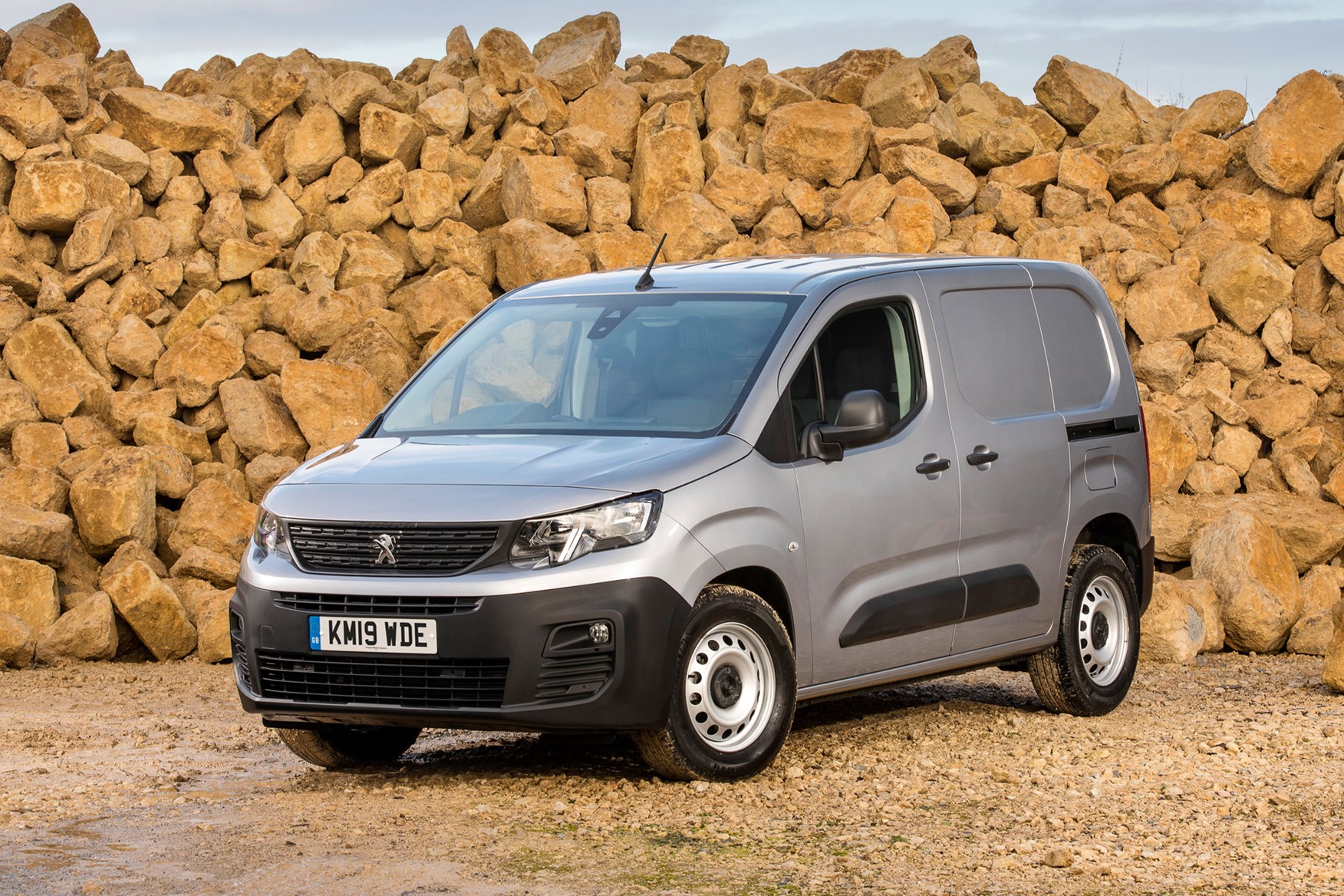
Peugeot Partner security
In terms of security, an alarm is available (not standard on all models) while the rear door hinges have been moved so they’re hidden when the doors are shut. This makes it much more difficult for potential thieves to break into the van.
The remote locking - which is standard on all models - has a feature that allows you to only unlock the cab or the load area, too.
Which Peugeot Partner is best for me?
Still struggling to work out which Peugeot Partner is best for you? Maybe the following will help.
Best Peugeot Partner for running costs
The BlueHDi 100 versions typically offer the most competitive running costs - the extra power makes them less stressed on the road, reducing fuel consumption - though exact mpg varies with trim level and payload. For example, Grip models will likely prove less efficient than others due to their mud and snow tyres and raised ride height.
All BlueHDi engines aside from the 75hp model come with stop-start as standard, which goes some way to increasing fuel economy and reducing emissions.
Best Peugeot Partner for payload
The Partner has payload potential of over 1,000kg on some models - that's a whole tonne, a huge amount for a small van. Look for examples with 1000 in the model name for maximum strength, though note that not all of these quite make the magic one-tonne mark.
See our dedicated Peugeot Partner Dimensions page for more details.
Best Peugeot Partner for value/standard equipment
If you don’t care about any car-like features or luxuries, the entry-level S will do the job.
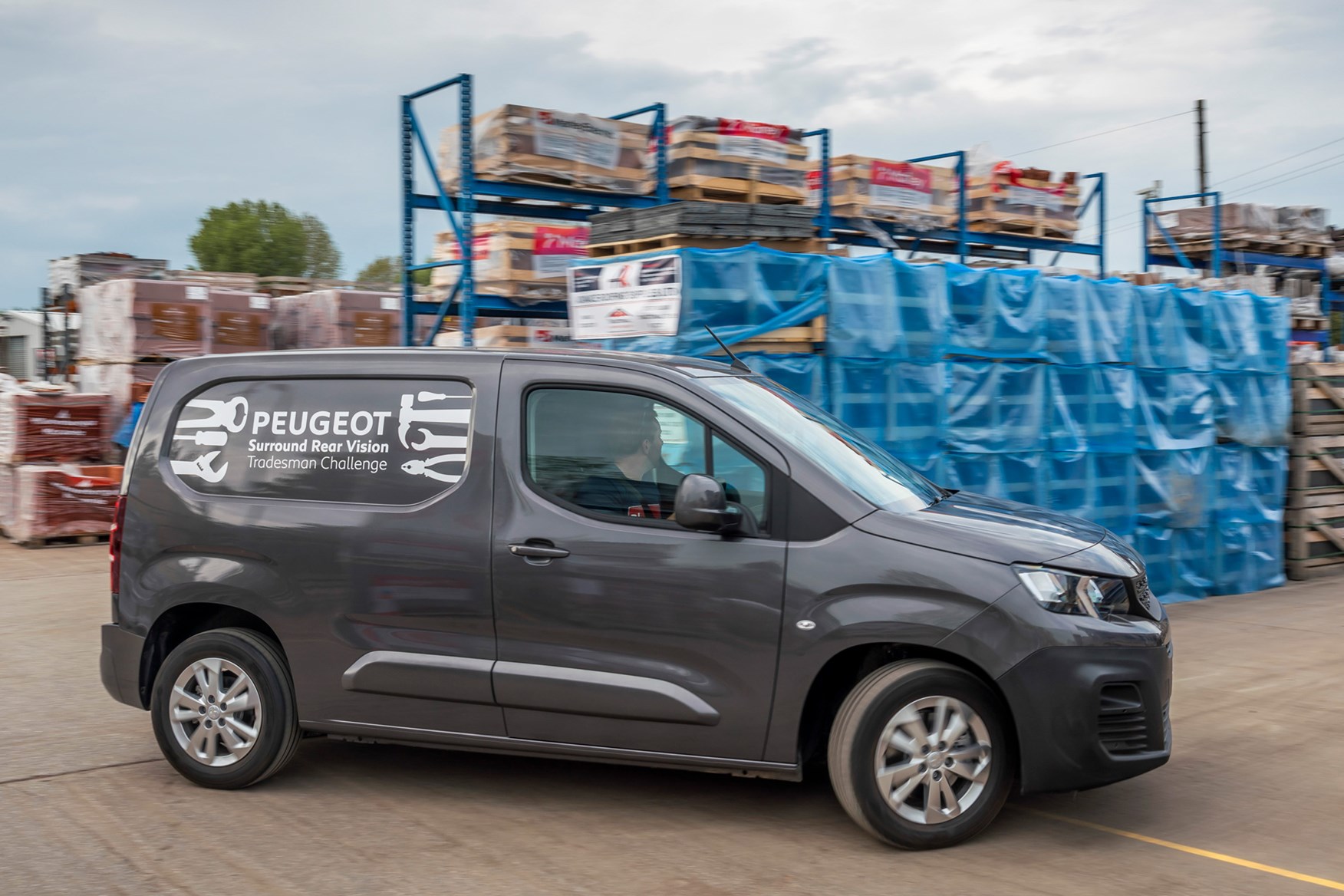
However, if you want more engine options, the Professional Premium+ is a better bet, with every motor available in a variety of payloads, plus a large amount of standard kit.
Grip models are best if you need something a tougher; top-spec Asphalt Premium+ models are well equipped and refined, but quite pricey.
Best Peugeot Partner for image
The Asphalt Premium+ is the most car-like of the line-up, with a long list of fitted kit that increases driving comfort.
This is the one to go for if you’re spending a lot of time behind the wheel, as all of those bits will add up to a more pleasant driving experience.
It also has the least van-like look, with attractive alloy wheels and more colour options.
Most popular Peugeot Partner engine
The BlueHDi 100 is the most popular engine available in the Partner - not only does it offer a good blend of performance and fuel economy, it's available with every trim level and in both body lengths.
However, for us the most versatile engine is the BlueHDi 130, making light work of long journeys. Plus it’s the only one available with an automatic gearbox (if that’s what you want or need).
After an insurance quote for a Peugeot Partner? Try mustard.co.uk.



